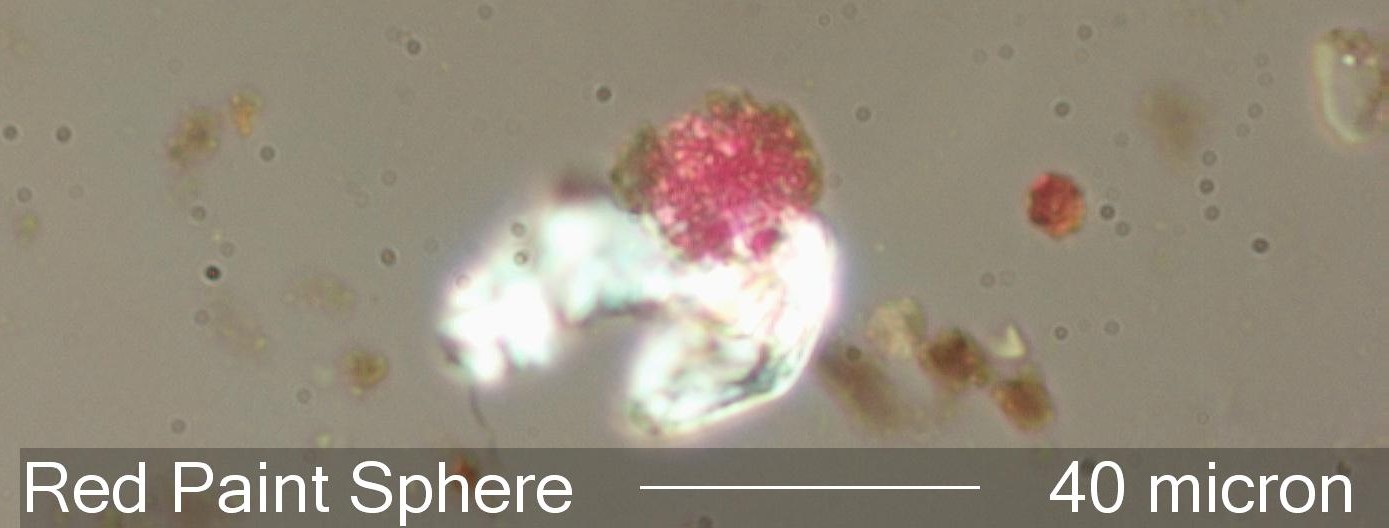Paint Sphere
The paint spheres in this image are red. There is one
larger paint sphere in the center above the paper fiber
fragment and one smaller one to the right. The large sphere contains the pigment and
a calcium carbonate opacifier and filler. The vehicle
(organic carrier) is transparent, isotropic, and colorless.
Transmitted Crossed Circular Polarized Light Illumination
Definition/Function:
Paint spheres are created by both spray painting and by brushes or roller used to paint.
Spray painting tends to create more paint spheres
per volume of paint used in the environment than brushing or rolling paint but these
other methods of applying paint still produce paint
spheres. Paint typically consists of an organic vehicle, an opacifier, pigments, bulking
agents, and curing agents. The vehicle is the
material that forms the film in which the other components are suspended. It is present
in solution or as a monomer in the "wet", pre-cured
paint. The opacifier is a material with a refractive index very different, usually
higher, than the cured vehicle. The difference in
refractive index results in light scatter which prevents anything under the applied
paint from showing through the final paint film. Titanium
dioxide is a common opacifier in most paints though calcium carbonate and other minerals
have been used. The pigment provides the color or
shade desired for the paint. In some instances the opacifier may also be the pigment.
There are often more than one pigment present in the
paint. The bulking agent is a less expensive filler that provides volume or bulk to the
paint. Clay is a common bulking agent but there are
many other materials that can be used as bulking agents. Curing agents are chemical
compounds added to the paint to assist in the proper
curing of the paint. They facilitate the formation of a film with the desired properties
but are not generally chemically bound to that film.
The curing agents can be leached from the film under some circumstances without damaging
the film itself.
Significance in the Environment:
The presence of paint spheres indicates that painting has taken place at this locality
or nearby. Paint spheres persist in the environment and
are an indication of how thorough a cleaning has taken place since the painting event
and how extensively contaminants were dispersed in the
environment during the activities associated with the painting event. The presence of
paint spheres may indicate a source for solvent odors.
Characteristic Features:
On close examination a thin film of the vehicle may be visible at the edges of the
sphere. The opacifier and the pigment may be visible as
particles often around a micrometer in diameter. Titanium dioxide is often present in
the sub-micrometer range but its birefringence is so
high that it will be visible with crossed polarized light even at that size. Bulking
agents, such as quartz or calcite, is often larger and
may be visible protruding slightly from the bulk of the sphere.
Associated Particles:
Paint spheres are often found with other construction debris such as sawdust, plaster,
magnetite spheres, glass fiber, etc. In an automotive
body shop or vehicle maintainece facility they are often associated with paint flakes,
magnetite spheres, abrasives, tire wear, metal particles,
rust, plastics, glass fiber, cotton rag fiber, and clear, colorless spheres of
"clearcoat". If this is from a paint spray booth then spherical
agglomerates of alkaline salts, organic residues, and pigment may also be present. If it
is from a local uncontrolled painting activity then
the spheres will not be associated with construction, body shop, or water scrubber
residues.
References:
Crown, David A., THE FORENSIC EXAMINATION OF PAINTS AND PIGMENTS, Charles C. Thomas
Publisher, 1968.


